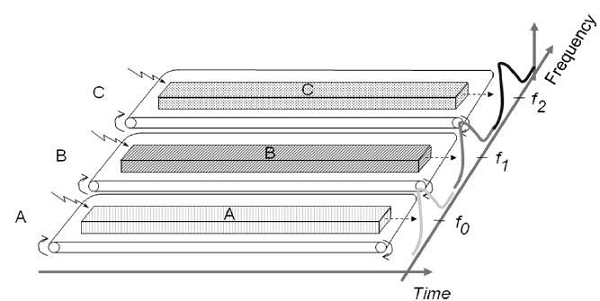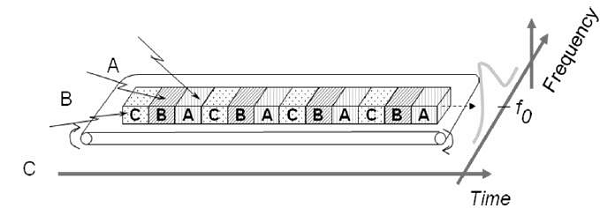
- Satellite Communication - Home
- Introduction
- Orbital Mechanics
- Kepler’s Laws
- Earth Orbit Satellites
- Look Angles & Orbital Perturbations
- Launching
- Subsystems
- AOC Subsystem
- TTCM Subsystem
- Power & Antenna Subsystems
- Transponders
- Earth Segment Subsystems
- Examples of Earth Stations
- Link Budget
- Multiple Access Techniques
- Satellite Services
- Global Positioning System
Multiple Access Techniques
Sometimes a satellites service is present at a particular location on the earth station and sometimes it is not present. That means, a satellite may have different service stations of its own located at different places on the earth. They send carrier signal for the satellite.
In this situation, we do multiple access to enable satellite to take or give signals from different stations at time without any interference between them. Following are the three types of multiple access techniques.
- FDMA (Frequency Division Multiple Access)
- TDMA (Time Division Multiple Access)
- CDMA (Code Division Multiple Access)
Now, let us discuss each technique one by one.
FDMA
In this type of multiple access, we assign each signal a different type of frequency band (range). So, any two signals should not have same type of frequency range. Hence, there wont be any interference between them, even if we send those signals in one channel.
One perfect example of this type of access is our radio channels. We can see that each station has been given a different frequency band in order to operate.

Lets take three stations A, B and C. We want to access them through FDMA technique. So we assigned them different frequency bands.
As shown in the figure, satellite station A has been kept under the frequency range of 0 to 20 HZ. Similarly, stations B and C have been assigned the frequency range of 30-60 Hz and 70-90 Hz respectively. There is no interference between them.
The main disadvantage of this type of system is that it is very burst. This type of multiple access is not recommended for the channels, which are of dynamic and uneven. Because, it will make their data as inflexible and inefficient.
TDMA
As the name suggests, TDMA is a time based access. Here, we give certain time frame to each channel. Within that time frame, the channel can access the entire spectrum bandwidth
Each station got a fixed length or slot. The slots, which are unused will remain in idle stage.

Suppose, we want to send five packets of data to a particular channel in TDMA technique. So, we should assign them certain time slots or time frame within which it can access the entire bandwidth.
In above figure, packets 1, 3 and 4 are active, which transmits data. Whereas, packets 2 and 5 are idle because of their non-participation. This format gets repeated every time we assign bandwidth to that particular channel.
Although, we have assigned certain time slots to a particular channel but it can also be changed depending upon the load bearing capacity. That means, if a channel is transmitting heavier loads, then it can be assigned a bigger time slot than the channel which is transmitting lighter loads. This is the biggest advantage of TDMA over FDMA. Another advantage of TDMA is that the power consumption will be very low.
Note − In some applications, we use the combination of both TDMA and FDMA techniques. In this case, each channel will be operated in a particular frequency band for a particular time frame. In this case, the frequency selection is more robust and it has greater capacity over time compression.
CDMA
In CDMA technique, a unique code has been assigned to each channel to distinguish from each other. A perfect example of this type of multiple access is our cellular system. We can see that no two persons mobile number match with each other although they are same X or Y mobile service providing companys customers using the same bandwidth.
In CDMA process, we do the decoding of inner product of the encoded signal and chipping sequence. Therefore, mathematically it can be written as
$$Encoded\:signal = Orginal\:data\:\: \times\:\: chipping\:sequence$$
The basic advantage of this type of multiple access is that it allows all users to coexist and use the entire bandwidth at the same time. Since each user has different code, there wont be any interference.
In this technique, a number of stations can have number of channels unlike FDMA and TDMA. The best part of this technique is that each station can use the entire spectrum at all time.